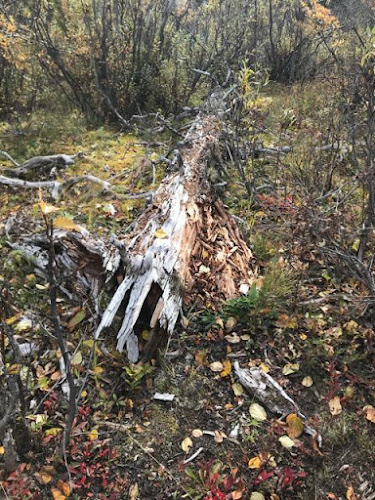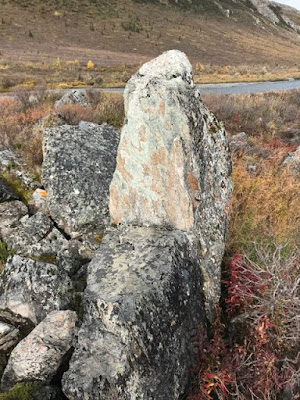I've been to six of the planned eight OLÉ classes on Pebble Mine. Here's my sense of this mega project to extract copper, gold, molybdenum, and other metals in a remote area adjacent to the world's largest salmon fishery.
1.
Obsession: Anyone who wants to undertake a project of this scope in the United States has to be an obsessive gambler. The amount of time and effort it takes to get all the permits, to get to the site, to put in infrastructure, to put in all the safety procedures, to woo the local communities, and to so raw mining and then to clean up everything is enormous. I suspect that for some people this is a challenge, like climbing the peaks of the world's highest mountains. I imagine for all who undertake such projects, the promise of great riches is a key factor. And apparently, getting a project along a certain part of the way, means the project can then be sold to someone else. And I'm not exactly sure who's money is at risk and what sort of tax benefits some may get out of losses in a project like this.
For example here are some of the Pebble Mine presentation slides that show a sense of the enormous scope of the project without getting into minutiae:
They have to process such enormous amounts of ore because the amount of valuable minerals is a tiny fraction.
This is just the site for the current 20 year planned mine. There's a much richer ore deposit to the east of this, but it's buried under bedrock and harder to get at. No one seems to believe that this project is going to end after 20 years. That's just the point where they will begin this process over again to then go after the rest of the ore.
2.
Complexity. There is no one person who has the knowledge and experience to be able to assimilate all the data in order to make a yes or no decision on a project like this. There's way too much technical data from too many different areas. We've been told about tests of chemical reactions, groundwater studies, surface water studies, acidity, toxicity, bulk tailings and pyritic tailings, porphyry intrusions, how copper affects salmon's ability to smell, the many federal and state regulations, and growing demand for copper in green economy,
Here's an overview of the Baseline Study - an attempt to document the existing conditions. Who is really going to read 30,000 pages?
3.
Many Decisions. There isn't just one decision. There are many permits and approvals to get - some of which can stop the project.
On the left are the US Army Corps of Engineers authorities. On the right are other federal laws. (clicking on any of the images will enlarge and focus them)
And there are approvals and permits needed from Alaska.
And here are all the groups involved in the Army Corps of Engineers Environmental Impact.
Although we got charts showing the decision making process, no one ever said who exactly makes the final decision. Is it just one person? Or several people? We still have two more sessions so I can ask next week. (I'll miss the last session, unfortunately.)
4.
Risk. In fact, this is NOT a technical decision. Ultimately it's a decision about risk. How much risk is there and is that risk worth the possible consequences? It's about the level of comfort with risk the decision maker has. There isn't just one risk, but many. At the extreme is the potentially catastrophic consequence of destroying the salmon in Bristol Bay. McNeil River bears are also nearby. Then there are the possibilities of lesser impacts on the salmon and other parts of the environment around the mine site. On the other side are the benefits, which the Pebble folks identified as employment for local people and the importance of copper in the new green environment. And, of course, the hundreds of millions of potential profit.
Here are some slides from the presentation of Bristol Bay Native Corporation which opposes the mine:
And this slide from the Pebble Mine folks:
5.
Ultimately It's A Values Based Decision. Aside from the decision maker(s) comfort with and exposure to risk in this situation, this all boils down to two opposing world views:
- The United States is based on individual freedom and capitalism which allow, even encourage, individuals and corporations to go out and exploit the world's God given natural resources to become rich and make the general economy better
- Human beings are part of nature, not APART from nature. Humans have been exploiting the planet and now it has reached the point that human caused climate change will make life and survival for humans and most other species of life much harder.
6. The Decision. The decision on Pebble will probably be determined not so much by all the technical details that are being presented, but by where on the spectrum between World Views #1 and #2 the decision maker(s) sit.
7.
Money. As I review all this, I realize that one important aspect* of the Pebble Mine project has not been discussed in the class - how the project is being financed. I made the assumption in #1 above that this was a gamble. But bits of conversation after class with presenters makes me question that. At one point I made a comment about Northern Dynasty (the company that has been at the lead in this project) and someone said, they won't be the ones who actually carry all this out. They will be sold out. So I have questions about how a deal like this is put together. Who actually has money at risk? Who is investing in this? What are their motives? How much of the expenses of doing all the preparation costs are only paper losses?
These all boil down to who is actually risking how much money and what do they stand to gain? To what extent do tax payers end up underwriting this because of tax deductions for business expenses or tax offsets for losses?
*Of course there are other important aspects that haven't been discussed that I haven't yet thought of, I'm sure.




















































